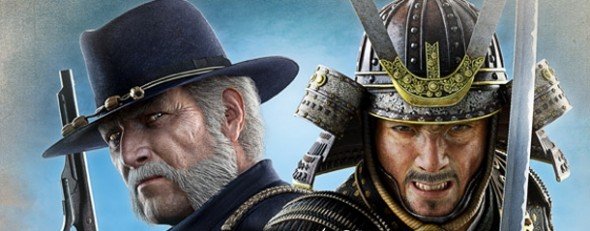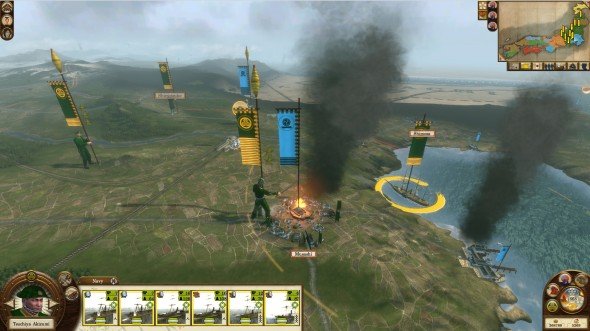
Through shallows of waving grass they come, hundreds of them, spears gripped, armour glittering, flags aflutter in the scented spring breeze. So many gaudy uniforms and ludicrous hats! So much splendour and misguided confidence.
The gaily coloured attackers are converging on my anvil – four formations of nervous Kiheitai riflemen. My hammers – twelve units of Sharpshooters and White Bear infantry – are waiting in nearby woodland for the perfect moment to strike.
That moment is close. In fact that moment is... wait-for-it...
wait-for-it...
NOW!

A flurry of mouse clicks and the trap springs shut. Instinctively, I select my single Gatling gun battery, and jab the 'H' key. The camera drops like a stricken pigeon. Suddenly I'm observing the increasingly chaotic battlefield from a spot just above and behind a single wheeled machinegun. Slap bang in the centre of the screen is a crosshairs. Left mouse button depressed, I drag this reticle along a line of charging spearmen. Targets are knocked off their feet, flicked like puppets into unnatural poses, sent twirling to the turf...
When the smoke clears and my finger finally lifts, the greensward in front of the battery is littered with dead and dying. An entire enemy unit – and one rather cynical games previewer – has been comprehensively blown away.
Keep up to date with the most important stories and the best deals, as picked by the PC Gamer team.
Directly controllable artillery isn't Fall of the Samurai's most significant feature, but it's probably its most irresistible and surprising. During my day in Horsham sampling this impressively big and bold standalone Shogun 2 expansion, I lost several scraps because I couldn't drag myself away from the third person shell slinging and MG mayhem. Nailing far-off commanders is deliberately difficult. The camera accompanies larger projectiles, but there's no sniper-style zoom view. A year of testing convinced the devs that too many aiming aids risked turning multiplayer matches into daft duels. It also persuaded them to plump for an over-the shoulder perspective rather than a context limiting first-person one.
While there will be occasions in FotS when you get to mow down serried rows of katana-clutching samurai with 400-roundsper- minute MGs and sophisticated longrange cannons, Creative Assembly are too serious about their history for it to be a regular occurrence. Despite the cinematic Last Samurai overtones of the launch trailer, the game's primary focus is the Boshin War (1868-1869) rather than the ill-fated Satsuma Rebellion (1877) that inspired much of the 2003 Tom Cruise movie. Both sides in this low-key civil war were enthusiastic modernisers, eager to lay their hands on the latest Western military tech and techniques.

Whether you choose to play as one of the three pro-Imperialist factions (Choshu, Satsuma or Tosa) or opt for one of the Shogun-loyal trio (Aizu, Jozai, Nagaoka), your approach to martial matters is likely to be much the same: you'll want to scramble up the pleasingly branchy and unfamiliar R&D bonsai as quickly as possible. Off the bat you'll probably have access to spear toters, matchlock men and static wooden-barrelled cannons, but to have any hope of spreading your dominion and surviving the coming countrywide convulsions, you'll want to tax, trade, and study your way towards units that owe more to the mechanical age than the medieval one.
In order to capture the feel of Japan's scarily swift transformation from feudal agrarian backwater to modern industrial state, the FotS clockface features incredibly fine gradations. Clicking the 'end turn' button advances your campaign a mere two weeks. With biting winters now lasting six turns, ponderous or ill-timed invasions will be costlier than ever.
Longer cold snaps aren't the only new feature the humble Total War grunt has to worry about. Now the poor buggers that do the trigger-pulling and swordslashing can be slain between battles by naval bombardment. Select a friendly fleet on the campaign map and a range circle appears. Any enemy army within this zone-o'-death may be pummelled without risk, with one mouse-click. You won't devastate targets, but hounding an invasion force as it trudges down a long coast road could make the difference between victory and defeat in a later battle.
Mark this moment. In Fall of the Samurai, Total War navies finally go from being amusing distractions to indispensable strategic tools. That bombardment ability can also be used to clobber cities, neutralise coastal batteries (a new buildable structure) and turn the tide in traditional ground battles. Friendly fleets within shellchucking range of a skirmish appear on the battle screen in the form of an interface tab. Select, position the targeting circle and, a few moments later, giant high-explosive hailstones will start hurtling down. It's the perfect way to punish a hillock-camper, or rip inviting holes in daunting frontlines. Watching a naval stonk land it's hard not to think of the Dardanelles and D-Day and wonder if the feature isn't preparatory in more ways than one.

Naval battles themselves are difficult to assess at this stage, as CA are still tinkering with such fundamentals as turning speeds, AI behaviours and hull strengths. The far-reaching guns and sturdy iron armour on mid- to late game vessels should give wet warfare a very different feel, as should such history-stretching novelties as torpedo boats. Totem Games, the makers of the Ironclads series, have delved into this curious period in naval history relatively recently, and it will be interesting to see how the two interpretations compare.
Exploiting steam power on land will be every bit as important as exploiting it on water. Total War has finally reached the train age, and watching the little beauties choo-chooing their way across the campaign map is – like spotting jets in the sky in a WWII flight sim – both delightful and faintly disconcerting. Unlocked and built in the same way as any other structure, stations in neighbouring provinces automatically form a steely link. The more provinces you connect, the more your trade revenue increases, and the more chance you have of responding quickly to unexpected incursions. CA community manager and ex-PCGregular Al Bickham described a game in which a well-developed rail network pretty much saved his bacon. Using steel horses he was able to gallop agents vast distances towards an invader. The agents did what agents do best – delayed, sabotaged and bribed – buying Al enough time to bolster defences in the threatened city.
Unsurprisingly, given the 300-year period shift, most of the cast of spies and rabble-rousers don't come direct from Shogun 2. Working alongside familiar Shinobi (ninjas) and Geisha are two faction-specific secret policemen – the Ishen-Shishi (Imperialist) and Shinsengumi (Shogunate) and the massively useful Foreign Veteran. Remember the nasty Colonel Bagley in The Last Samurai? That's the kind of calculating, conscience-free merc you get when you employ a foreign veteran. With one of these embedded in an army, your troops will move, reload and gain experience faster. There's even the possibility of using them to eliminate enemy generals through duels – though that sounds like a very dicey job for such invaluable individuals.

